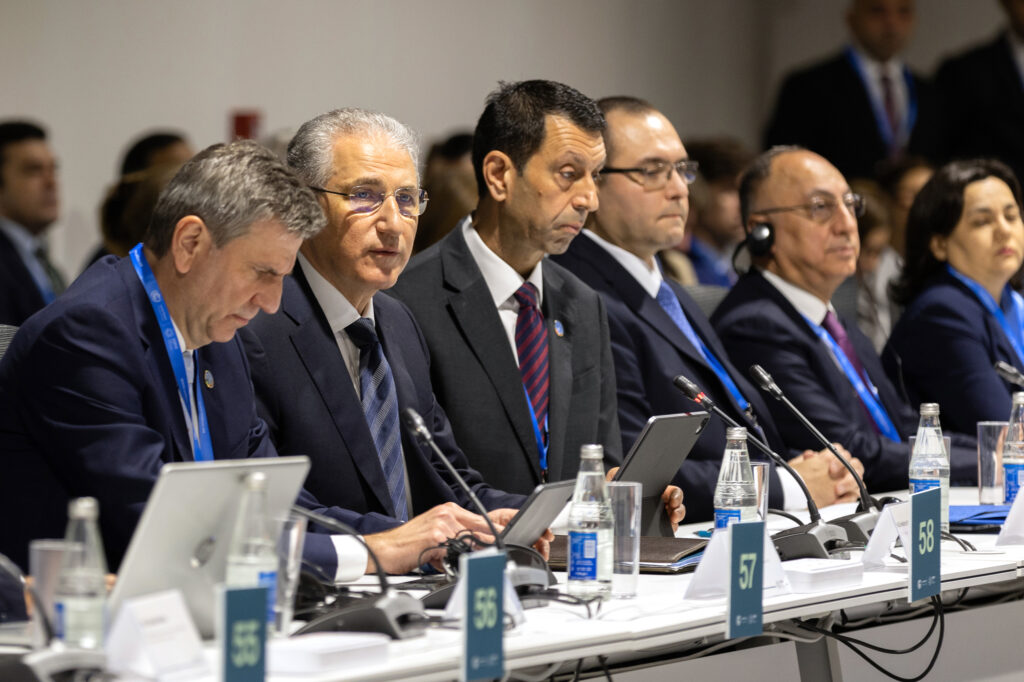Delegates at this year’s United Nations conference on climate change, known as COP29, have spent the last 11 days attempting to hammer out a deal on global climate finance, but this week the world’s farms and food systems got a little share of the spotlight.
On Tuesday, at the summit’s Food, Agriculture and Water Day, negotiators, governments and advocacy groups gathered for dozens of discussions about how to better enlist agricultural practices in slowing the worst impacts of climate change. At the last two U.N. conferences, food and agriculture got more attention than in previous years, particularly at the 2023 event, held in Dubai.
“In Dubai, there was quite a lot of momentum of food and food systems transformation,” said Clement Metivier, who currently leads advocacy efforts for WWF-UK. “We want to maintain that dynamic.”
The shifting focus, many observers said, is a long overdue and critically important acknowledgement of agriculture’s significant greenhouse gas emissions—about one-third of the global total. Left unchecked, emissions from agriculture and food systems will make it impossible to meet global climate goals, even if the world were to stop burning fossil fuels today.
The primary goal of the annual gatherings is for countries and their delegations to negotiate how they will meet their commitments to lower climate-warming emissions under the 2015 Paris Agreement. Every five years countries submit detailed climate action plans, known as Nationally Determined Contributions (NDCs), to the secretariat of the United Nations Framework Convention on Climate Change (UNFCCC).
The next NDCs are due in 2025, prompting agriculture advocates at this year’s summit to push countries to include more specifics on how they plan to reduce agricultural emissions—and include them in a way that accurately represents emissions from the food systems in their countries. A 2021 report from some of the world’s top climate scientists and U.N. agencies found that countries’ NDCs failed to convey the full extent of their agricultural emissions, often omitting deforestation linked to food production and food waste, which are significant sources of greenhouse gas emissions. The report said the oversight meant that countries had even greater potential to cut emissions from their food sectors.
At last year’s COP in Dubai, 160 countries, including the United States, signed on to the “Declaration on Sustainable Agriculture, Resilient Food Systems, and Climate Action,” in which they agreed that “any path to fully achieving the long-term goals of the Paris Agreement must include agriculture and food systems.”
Over the coming year, countries’ plans will start to take shape in the lead-up to the next COP, which is being held in Belem, Brazil, in the heart of the Amazon rainforest.
“COP30 is going to be a big opportunity to make the connection between deforestation and food,” Metivier said, noting that countries committed again last year to stop deforestation and forest degradation by 2030. “Next year is going to be a big opportunity to put that in the spotlight.”
Some of the notable agriculture and food-related developments from the current COP include:
- More than 30 countries signed on to a pledge to reduce methane from food loss and waste, which accounts for between 8 and 10 percent of global methane emissions. The signatories include countries that emit nearly half of the world’s methane from organic waste, including the U.S. The pledge is part of the broader Global Methane Pledge to cut global methane emissions 30 percent below 2020 levels by 2030.
- The Alliance of Champions for Food Systems Transformation, a coalition of five countries that formed at last year’s COP to drive “systemic change” in food systems, issued a progress report highlighting some advances in those countries. One of the founding countries, Sierra Leone, said it had put infrastructure in place that would prevent deforestation for rice plantations, for example. Additional countries, including Italy and Vietnam, said they would consider joining the alliance.
- The Director-General of the U.N.’s Food and Agriculture Organization (FAO), Qu Dongyu, said last week that agriculture and food systems received about $29 billion in climate development finance in 2022, or roughly 23 percent of the total climate finance. That’s despite agriculture and food systems being responsible for about one-third of greenhouse gas emissions, 90 percent of deforestation and 60 percent of diversity loss. Qu said in order to meet net-zero targets, countries will need $1 trillion a year until 2030.
- The FAO and the leaders of this year’s COP confirmed the launch of the Baku Harmoniya Climate Initiative for Farmers “to acknowledge the fundamental role of farmers as agents of climate action.” The initiative, which was confirmed earlier this year, intends to organize climate-focused food and agriculture initiatives in one platform where farmers can access information and support.
- A newly formed coalition representing more than 50 million family farmers across Africa, Latin America, Asia and the Pacific, called Family Farmers for Climate Action, released a report that says small-scale farmers, which represent the bulk of the world’s farmers, are receiving only 14 percent of the more than $9 billion in public financing for agriculture. Small-scale farmers produce 70 percent of the food consumed in Africa and 80 percent in Asia.
- An analysis of attendees at this year’s COP found that agriculture industry lobbyists, including from some of the biggest-polluting livestock companies, once again had a heavy presence at the event. A new report by the Changing Markets Foundation, released during the COP, found that most of the 11 countries that are home to the largest meat and dairy companies—many of which were represented at the COP—lack sufficient national strategies to reduce agricultural emissions.
- Soil conservation advocacy groups delivered a set of policy recommendations to the UNFCCC this week, urging more climate financing to help restore degraded soils. A new report from one of the groups, Save Soil, found that if soil degradation continues unchecked, soils could begin releasing stored carbon. The FAO projects that 90 percent of the world’s topsoil is at risk of degradation by 2050 because of unsustainable farming practices.
- The Agriculture Innovation Mission for Climate, a coalition led by the United Arab Emirates and the U.S., announced that funding for “climate smart” agriculture had risen to $29.2 billion, from $17 billion, since the last COP. The funding comes from government and private sector food and farming companies.
About This Story
Perhaps you noticed: This story, like all the news we publish, is free to read. That’s because Inside Climate News is a 501c3 nonprofit organization. We do not charge a subscription fee, lock our news behind a paywall, or clutter our website with ads. We make our news on climate and the environment freely available to you and anyone who wants it.
That’s not all. We also share our news for free with scores of other media organizations around the country. Many of them can’t afford to do environmental journalism of their own. We’ve built bureaus from coast to coast to report local stories, collaborate with local newsrooms and co-publish articles so that this vital work is shared as widely as possible.
Two of us launched ICN in 2007. Six years later we earned a Pulitzer Prize for National Reporting, and now we run the oldest and largest dedicated climate newsroom in the nation. We tell the story in all its complexity. We hold polluters accountable. We expose environmental injustice. We debunk misinformation. We scrutinize solutions and inspire action.
Donations from readers like you fund every aspect of what we do. If you don’t already, will you support our ongoing work, our reporting on the biggest crisis facing our planet, and help us reach even more readers in more places?
Please take a moment to make a tax-deductible donation. Every one of them makes a difference.
Thank you,



